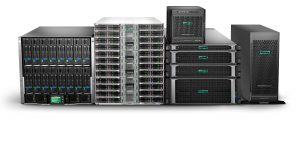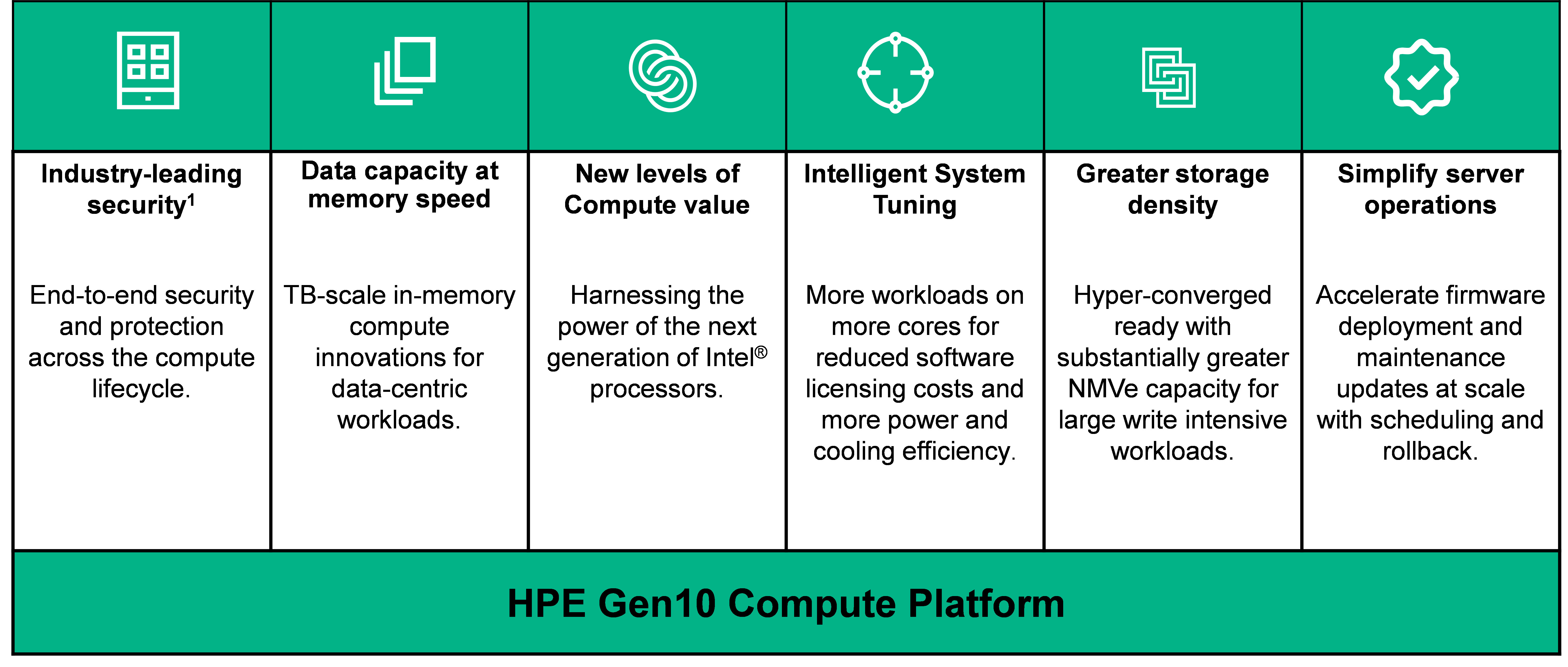Introducing ProLiant Gen10
The industry-leading success of HPE ProLiant stems in part from their ongoing commitment to providing a complete industry-standard server infrastructure that delivers innovation, quality, security and proven performance.
HPE ProLiant Gen10 is available in these families (outside of BladeSystem, Synergy, and Apollo platforms…but that’s a whole other discussion!):
- HPE ProLiant MicroServer

- HPE ProLiant Rack family – DL360, DL380, DL560 and DL580 servers – we will dive deeper into this family below as these are by far the most popular server sold.
- HPE ProLiant Tower family – ML110 and ML350 servers
HPE ProLiant Gen10 Rack Servers
The new HPE Gen10 rack servers are “The World’s Most Secure Industry Standard Servers”. This bold claim is founded on a unique silicon root of trust technology along with a myriad of other differentiating security technologies that only HPE offers.
The DL family of servers are the most flexible, reliable, and performance-optimized ProLiant rack servers. As HPE continues to provide industry-leading compute innovations, the ProLiant Gen10 rack portfolio, with flexible choices and versatile design, along with improved energy efficiencies, ultimately lowers TCO.
Integrated with a simplified, but comprehensive management suite and industry-leading support, the ProLiant Gen10 rack portfolio delivers a more reliable, fast, and secure infrastructure solution. It also helps increase IT staff productivity, and accelerates service delivery.
In addition, the rack portfolio is performance-optimized for multi-application workloads to significantly increase the speed of IT operations and enable IT to respond to business needs of any size, faster.
The HPE ProLiant Gen10 rack portfolio provides:
- Up to 27x faster checkpoint operations enabling significantly faster business operations and 20x reduction in database restart time preserving maximum uptime.
- Up to a 70 percent performance gain and 27 percent increase in cores
- Firmware anchored directly into the Silicon (Root of Trust), providing protection through the entire supply chain.
- 66 percent greater memory bandwidth increasing application performance for memory-intensive applications
Differentiating Innovations
Software-defined compute and converged infrastructure to run diverse workloads and applications across traditional and multi-cloud environments:

The bold claim that the ProLiant Gen 10 platform “The World’s Most Secure Industry Standard Servers” is founded on a unique silicon root of trust technology along with several other differentiating security technologies that HPE offers:
- Silicon root of trust—creates a digital fingerprint in the silicon and ensures the server will never boot with compromised firmware.
- Firmware threat detection—know on a daily basis whether firmware has been compromised. In the event of a breach, you can automatically recover to a known trusted state and quickly get the sever operational again.
- Server data security—implementing the highest level of security algorithms, known as CNSA-suite, you can keep your most confidential information within your server protected.
- Runtime Firmware Validation—Millions of lines of firmware code run before server operating system boots and with Runtime Firmware Validation, enabled by iLO Advanced Premium Security Edition, the server firmware is checked every 24 hours verifying validity and credibility of essential system firmware.
- Intel® Xeon® Processor Scalable Family—Next generation industry standard CPUs with faster processing, higher speed memory access, enhanced software-defined management and security.
- HPE Scalable Persistent Memory Non-Volatile DIMM (NVDIMM)—In-memory compute performance, accelerating applications for fast caching and storage, reduce transaction costs for latency-sensitive workloads, and deploy bigger, more affordable datasets to gain new insights from large memory pools.
- Intelligent System Tuning—Automate application performance tuning with core boosting and jitter smoothing technology. This new set of server tuning technologies enable you to dynamically configure server resources to match specific workloads for a more intelligent server environment.
- Hyper-Converged Ready Storage Density—Substantially greater NVMe capacity for large write intensive workloads needing advanced caching/tiering.
As an HPE Platinum Data Center partner, Zunesis can work with your organization to analyze your current environment. Whether you currently have ProLiant or other OEM x86 servers, we can develop a plan for migration to the ProLiant Gen 10 platform.
Zunesis can also provide installation, workload migration, and knowledge transfer services to make your migration as seamless as possible. We will provide a complete solution that is “Ready to Go”!
If your servers are more than 3 years old (for example, ProLiant Gen 8 or older), your organization will benefit from working with Zunesis and HPE on a Customer Connect discussion on a potential migration to Gen 10 architecture.
For details about HPE ProLiant Gen 10 servers, Zunesis Customer Connect Services, or more…contact your Zunesis Account Manager.
Over the last several months, Hewlett Packard Enterprise (HPE) has introduced new some technologies and, of course, new terminology to go along with them. We now have terms like “Composable Infrastructure” and the “Virtual Vending Machine” to understand. Here’s a quick overview of what these trendy new terms mean:
Composable Infrastructure
 This is HPE-speak for one of their newest products: Synergy. Recognized as the infrastructure of the future, Composable Infrastructure is designed to run traditional workloads as efficiently as possible, while accelerating value creation for a new breed of applications that leverage mobility, Big Data, and cloud-native technologies. This is a new approach to traditional architecture is built to allow the IT organization to work with the speed and flexibility of the cloud in their own data center.
This is HPE-speak for one of their newest products: Synergy. Recognized as the infrastructure of the future, Composable Infrastructure is designed to run traditional workloads as efficiently as possible, while accelerating value creation for a new breed of applications that leverage mobility, Big Data, and cloud-native technologies. This is a new approach to traditional architecture is built to allow the IT organization to work with the speed and flexibility of the cloud in their own data center.
For more information, visit the official site here.
Virtual Vending Machine
 Recently, HPE announced the new Hyper Converged 380. This is based on one of their most proven technologies, the ProLiant DL380 Gen9 platform; and it introduces the concept of a Virtual Vending Machine. The solution integrates compute, storage, and virtualization. It features simplified upgrades, increased uptime and service levels. The new software-defined intelligence layer provides advanced analytics and reduces the costs to start, scale, and protect. The HC380 puts you on a direct path to composability.
Recently, HPE announced the new Hyper Converged 380. This is based on one of their most proven technologies, the ProLiant DL380 Gen9 platform; and it introduces the concept of a Virtual Vending Machine. The solution integrates compute, storage, and virtualization. It features simplified upgrades, increased uptime and service levels. The new software-defined intelligence layer provides advanced analytics and reduces the costs to start, scale, and protect. The HC380 puts you on a direct path to composability.
Check out the site for more details.
Ask us for more information about either of these new technologies and how they can fit into your greater data center roadmap.

